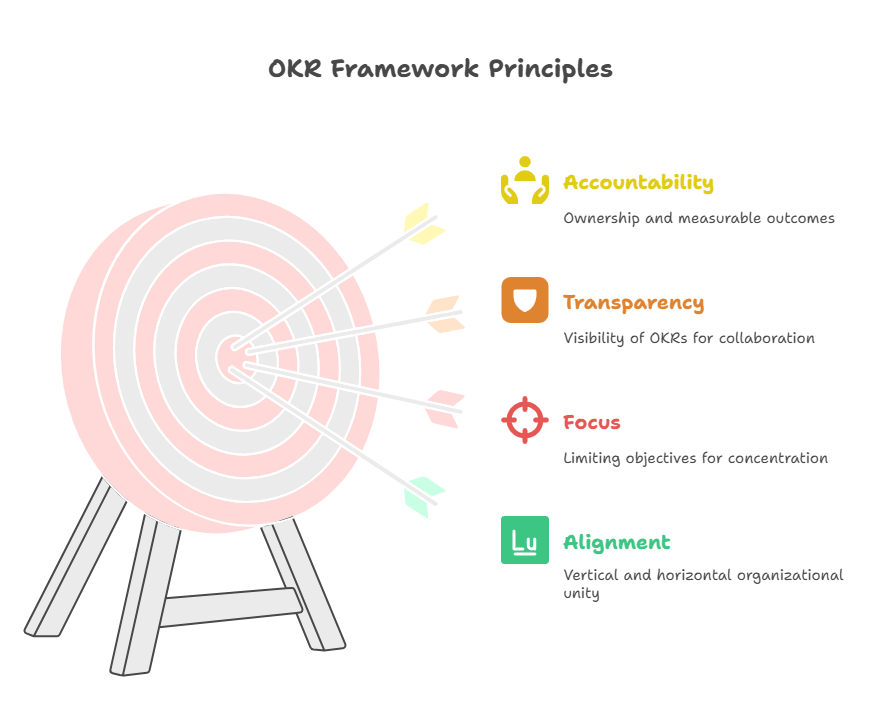What is OKR? A Complete Guide to Objectives and Key Results
Learn what OKRs are, how they work, and why this goal-setting framework helps teams align, focus, and measure progress toward ambitious objectives.
What Are OKRs?
Objectives and Key Results (OKRs) is a goal-setting framework used by individuals, teams, and organizations to define measurable goals and track their outcomes. This collaborative methodology helps set challenging, ambitious goals with measurable results that create focus, accountability, transparency, and alignment within an organization.
The framework was popularized by John Doerr, who learned about the concept at Intel in 1975 and later published the influential book Measure What Matters in 2018. Today, companies of all sizes use OKRs to bridge the gap between strategy and execution.
The Two Components of OKRs
Objectives
The objective represents the qualitative, inspirational goal you want to achieve. It should be significant, concrete, and clearly defined—something that motivates and provides direction. A good objective answers the question "Where do we want to go?"
Examples of effective objectives include:
- Launch a revolutionary new product feature
- Become the market leader in our industry
- Improve customer satisfaction to industry-leading levels
Key Results
Key results are the measurable success criteria used to track achievement of the objective. Typically, you'll have 3-5 key results per objective, and they should be specific, measurable, and time-bound. Key results answer "How will we know we're getting there?"
According to the framework definition, OKRs comprise an objective and 3–5 key results that serve as measurable success criteria.
How OKRs Work in Practice
OKRs combine clear objectives with a small set of specific, measurable results and a regular process of reviewing progress toward those measures. This combination is what makes OKRs truly useful for organizations.
The framework operates on several key principles:

- Alignment: OKRs create vertical and horizontal alignment across the organization
- Focus: By limiting the number of objectives, teams concentrate on what matters most
- Transparency: Everyone can see each other's OKRs, fostering collaboration
- Accountability: Clear ownership and measurable outcomes create responsibility
OKR Examples
Understanding OKRs becomes easier when you see them in action. Here's a typical OKR structure:
Objective: Improve product quality and reliability
- Key Result 1: Reduce critical bugs by 50%
- Key Result 2: Achieve 99.9% uptime
- Key Result 3: Increase customer satisfaction score from 4.0 to 4.5
Objective: Expand market presence in Europe
- Key Result 1: Grow European revenue by 30%
- Key Result 2: Establish partnerships with 5 local distributors
- Key Result 3: Achieve 15% market share in target countries
Benefits of Using OKRs
Organizations adopt OKRs because they provide numerous advantages. As a goal management framework, OKRs help organizations define their purpose, reach goals, and measure success.
Key benefits include:
- Clarity and focus on what truly matters
- Better alignment across teams and departments
- Increased engagement through transparent goal-setting
- Data-driven decision making with measurable outcomes
- Faster adaptation through regular check-ins and adjustments
OKRs vs Other Frameworks
Many professionals wonder how OKRs differ from other performance management tools. While KPIs (Key Performance Indicators) measure ongoing performance, OKRs are about driving change and achieving specific goals within a timeframe.
OKRs work alongside other frameworks rather than replacing them. They complement agile methodologies, strategic planning, and performance management systems by providing the goal-setting structure that ensures everyone moves in the same direction.
Getting Started with OKRs
Implementing OKRs requires commitment and practice. Start with a pilot team, set realistic but ambitious goals, and establish regular check-in rhythms. Remember that OKRs are meant to be challenging—achieving 70-80% of an ambitious OKR is often considered success.
For visual thinkers and teams looking to implement OKRs effectively, ClipMind offers tools to create and visualize your OKR structure. The platform's mind mapping capabilities can help you brainstorm objectives, define key results, and maintain alignment across your organization.
Whether you're a product manager setting quarterly goals, a marketing team launching campaigns, or an individual planning personal development, OKRs provide the structure to turn aspirations into measurable outcomes. The framework's simplicity and power make it accessible to organizations of any size, from startups to enterprise corporations.
 ClipMind
ClipMind